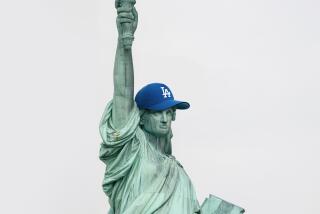Timeless Images of L.A.’s Bygone ‘Poor Man’s Shangri-La’
Sometimes even rough times gain a touch of sweetness when looked back on half a century later. That is very much the case with “Chavez Ravine, 1949,” a beautiful book that is a testament to the Mexican Americans who lived in the hills and hollows that later became the home of Dodger Stadium and its parking lots.
These people were a true example of that much-overused word, “community,” and they and their homes were brushed aside by the local, state and federal governments who were certain they knew what was best for them.
The vibrant images in this book originated in an unexpected way. Photographer Don Normark, then 18, was looking for a hill from which to take a postcard view of Los Angeles. “I didn’t find the view,” he writes, “but when I looked over the other side of the hill I was standing on, I saw a village I never knew was there.
“Hiking down into it, I began to think I had found a poor man’s Shangri-La,” he continues. “It was mostly Mexican and certainly poor, but I sensed a unity to the place, and it was peacefully remote.
“The people seemed like refugees--people superior to the circumstances they were living in. I liked them and stayed to photograph. I didn’t know it at the time, but I was in Chavez Ravine.”
The 88 striking black-and-white photographs in this book that Normark took on a dozen trips to the three communities that made up Chavez Ravine--La Loma, Bishop and Palo Verde--speak of dignity, serenity and, across this span of years, a certain stillness too. A girl tries on her confirmation dress, her smile at once shy and radiant. Boys spar playfully. A young man hanging onto a tree limb looks as serious as only a 21-year-old can. Old men chat and smile. A nun peers from the door of Santo Nin~o Church. A young woman in blouse and slacks decks an outdoor altar with flowers for the feast of Corpus Christi.
In 1950, five of Normark’s photographs from Chavez Ravine were included in a show of photographers that included the likes of Henri Cartier-Bresson, Dorothea Lange and Wright Morris. Normark was not outclassed. He went on to take photographs for Sunset and other magazines, and it was not until he returned to Chavez Ravine in the 1970s that he learned he had, unknowingly, photographed a village about to be swept over a precipice.
In 1946, the Los Angeles City Planning Commission undertook a study of the city’s “blighted areas” and chose 11 for correction. One was Chavez Ravine, cited for improper use of land, poor street patterns, a high proportion of substandard housing, poor sanitation, juvenile delinquency and the presence of tuberculosis.
With money from the federal government under the National Housing Act of 1949, public housing would be built on the site. One of the architects was Richard Neutra. Ravine residents would get first chance to move into the new “Elysian Park Heights development.”
The plan never materialized. Attacked as “creeping socialism,” the development was never built. But in the meantime, most of the residents had been evicted and paid little by the government for their “substandard housing.”
The land lay largely empty until Walter O’Malley, looking for a new home for the Brooklyn Dodgers, and Mayor Norris Poulson, whose campaign for mayor in 1953 had attacked public housing, came together in the late 1950s to plan Dodger Stadium on the site of the “poor man’s Shangri-La.”
The former residents of Chavez Ravine formed a group called Los Desterrados, “The Uprooted.” Once a year they have a picnic in Elysian Park. Normark got in touch with them; their recollections and his photographs make up this handsome and moving book.
If there is any consolation in this bittersweet story, it must be that in Los Angeles, 50 years later, Latinos may hope that they will no longer be pushed around for their own good by the power structure. For they are part of the power structure now.
More to Read
Sign up for our Book Club newsletter
Get the latest news, events and more from the Los Angeles Times Book Club, and help us get L.A. reading and talking.
You may occasionally receive promotional content from the Los Angeles Times.










